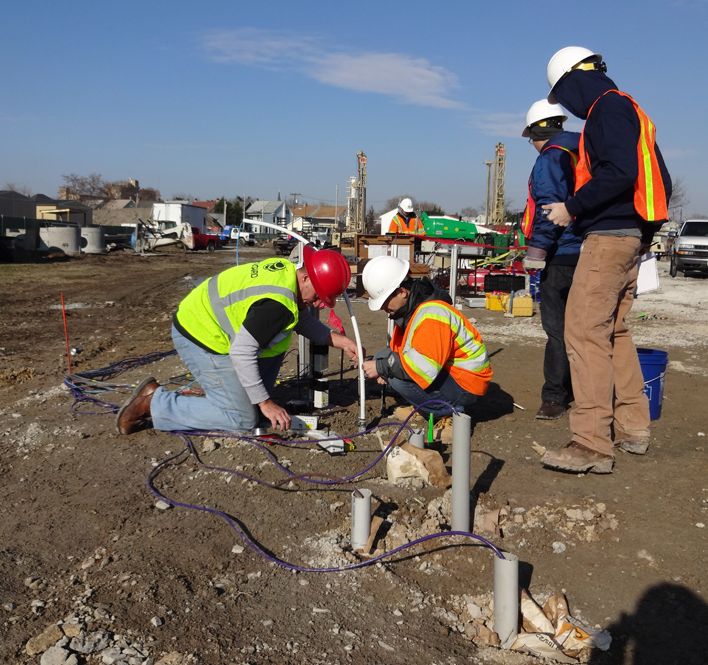Project Geotechnical Engineer Proficiency for Large-Scale Dope
Wiki Article
Exactly How Consulting Engineers Enhance Geotechnical Engineering Projects: Insights Into Their Experience, Techniques, and Collaborative Approaches
Consulting designers are pivotal in improving geotechnical design projects, using their specialized knowledge to navigate the intricacies of subsurface conditions. Their collective techniques foster communication among diverse job stakeholders, inevitably shaping the project's trajectory.Function of Consulting Engineers
The expertise of speaking with engineers in geotechnical design is basic to the effective implementation of construction projects. These professionals play a critical function in examining dirt and rock homes, which are important variables affecting layout and building and construction choices. By conducting comprehensive site investigations, speaking with engineers gather vital information that notifies the style process, guaranteeing jobs are developed on steady and suitable ground.Consulting designers additionally give invaluable understandings right into danger administration (geotechnical geologist). They identify potential geotechnical hazards, such as landslides, dirt liquefaction, and negotiation problems, enabling stakeholders to execute efficient mitigation approaches. Their knowledge aids in enhancing foundation styles, which can lead to considerable price savings and improved safety
Furthermore, getting in touch with designers offer as an important web link between task owners, engineers, and professionals. Their capability to translate complicated geotechnical data into actionable suggestions fosters cooperation and helps with educated decision-making throughout the job lifecycle. This multidisciplinary technique not only boosts job effectiveness but additionally makes sure compliance with governing standards and ideal practices.
Trick Approaches in Geotechnical Design

One primary approach is site examination, which includes performing area examinations and research laboratory evaluations to collect information on subsurface problems. Strategies such as Standard Infiltration Testing (SPT) and Cone Penetration Testing (CPT) are widely used to evaluate soil stratigraphy and strength. Furthermore, geophysical approaches, consisting of seismic and electric resistivity studies, give non-invasive methods to analyze subsurface features.
An additional essential technique is mathematical modeling, which makes it possible for designers to replicate different situations and predict how soil-structure interactions will certainly act under different loading conditions. Finite Element Evaluation (FEA) is a typical technique utilized in this context.
Furthermore, the design of structures, maintaining structures, and earthworks relies greatly on these methods - geotechnical geologist. By integrating advanced logical devices with area data, speaking with engineers can develop customized options that deal with specific task difficulties, ultimately adding to the security and safety of building and construction jobs
Significance of Dirt Analysis
Soil evaluation serves as a fundamental element in geotechnical design, providing necessary insights right into the physical and chemical residential or commercial properties of dirt necessary for efficient construction planning. Recognizing soil attributes is crucial for identifying its load-bearing ability, drainage habits, and possibility for settlement or instability. In-depth dirt examinations, including sampling and research laboratory screening, help determine criteria such as dirt type, wetness material, thickness, and shear strength.
These analyses notify the option of appropriate construction methods and products, inevitably affecting project security and durability. As an example, natural dirts may require different foundation styles contrasted to granular dirts, necessitating tailored engineering options. Soil analysis aids in identifying contaminants that can posture threats to human wellness or the setting, enabling for the advancement of mitigation techniques.
Integrating soil analysis right into the very early stages of job development helps to decrease unpredicted difficulties, making sure that engineers can anticipate and resolve possible problems before they escalate. By establishing a comprehensive understanding of the site conditions, speaking with engineers can maximize style efficiency and lower expenses, thus enhancing the total success of geotechnical engineering tasks.
Collective Methods in Tasks
Successful geotechnical projects usually depend upon collaborative strategies that unite varied expertise from numerous disciplines. Reliable partnership amongst speaking with designers, geologists, ecological scientists, and building and construction professionals is critical for dealing with intricate challenges and maximizing project results. By leveraging the unique abilities and expertise of each team participant, projects can take advantage of an all natural understanding of the site conditions, governing requirements, and engineering restraints.Regular communication and interdisciplinary conferences facilitate the sharing of insights and promote a society of teamwork. These collective initiatives make it possible for the identification of prospective threats early in the task lifecycle, permitting timely reduction approaches. Furthermore, integrating responses from stakeholders, consisting of local neighborhoods and regulative firms, ensures that all perspectives are thought about, improving job approval and compliance.
Additionally, the combination of advanced innovations, such as Geographic Info Solution (GIS) and Building Details Modeling (BIM), further enhances collaboration. These devices permit the real-time sharing of information and visualization of geotechnical problems, advertising educated decision-making. Eventually, a collective technique not only enhances job execution but also lays the structure for cutting-edge options to complicated geotechnical engineering challenges.
Influence On Task End Results

Consulting engineers use innovative methodologies such as risk assessment and predictive modeling, which boost the accuracy of task projections. Their ability to incorporate innovative technologies, like geotechnical instrumentation and data analytics, additionally fine-tunes the layout and building procedures. Because of this, projects experience enhanced effectiveness, minimized costs, and decreased hold-ups.
Moreover, geotechnical works fostering effective interaction and collaboration among staff member improves analytical capacities. When obstacles emerge, a joined front permits quick recognition of solutions, avoiding potential troubles. Ultimately, the joint initiatives of consulting designers add to better end results, guaranteeing that projects meet both governing requirements and client expectations.
Verdict

Report this wiki page